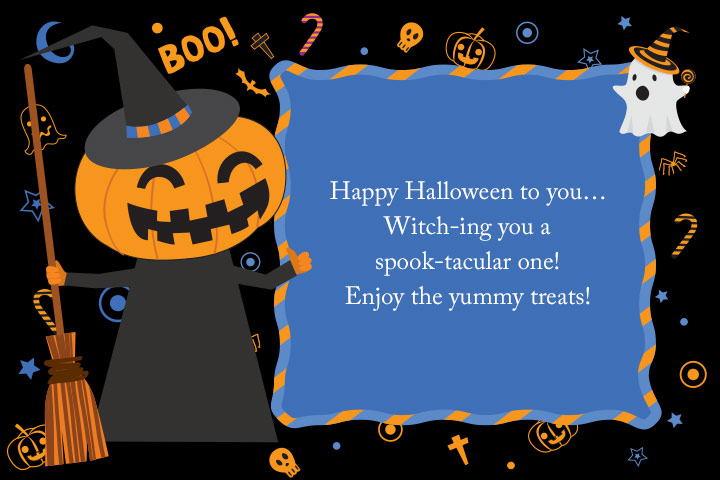Hi everyone, hope you are all in good spirits despite the wet and freezing cold weather that we are currently having here in the U.K. This week’s post is all about ‘Halloween’ and how it came to be, as it is almost upon us once again. Each year Halloween is celebrated on October 31st. A day when we take our children out all dressed in their costumes for trick-or-treating. It has become a sugar filled holiday.

On May 13, A.D. 609, Pope Boniface IV dedicated the Pantheon in Rome in honor of all Christian martyrs, and the Catholic feast of All Martyrs Day was established in the Western church. Pope Gregory III later expanded the festival to include all saints as well as all martyrs, and moved the observance from May 13 to November 1. In A.D. 1000, the church made November 2 All Souls’ Day, a day to honor the dead. The All Saints’ Day celebration i.e big bonfires, parades and dressing up in costumes as saints, angels and devils was also called All-hallows or All-hallowmas (from Middle English Alholowmesse meaning All Saints’ Day) and the night before it, the traditional night of Samhain in the Celtic religion, began to be called All-Hallows Eve and, eventually, Halloween.
By the end of the Middle Ages, the secular and the sacred days had merged. The Reformation essentially put an end to the religious holiday among Protestants, although in Britain especially Halloween continued to be celebrated as a secular holiday. Along with other festivities, the celebration of Halloween was largely forbidden among the early American colonists, although in the 1800s there developed festivals that marked the harvest and incorporated elements of Halloween. When large numbers of immigrants, including the Irish, went to the United States beginning in the mid 19th century, they took their Halloween customs with them, and in the 20th century Halloween became one of the principal U.S. holidays, particularly among children.
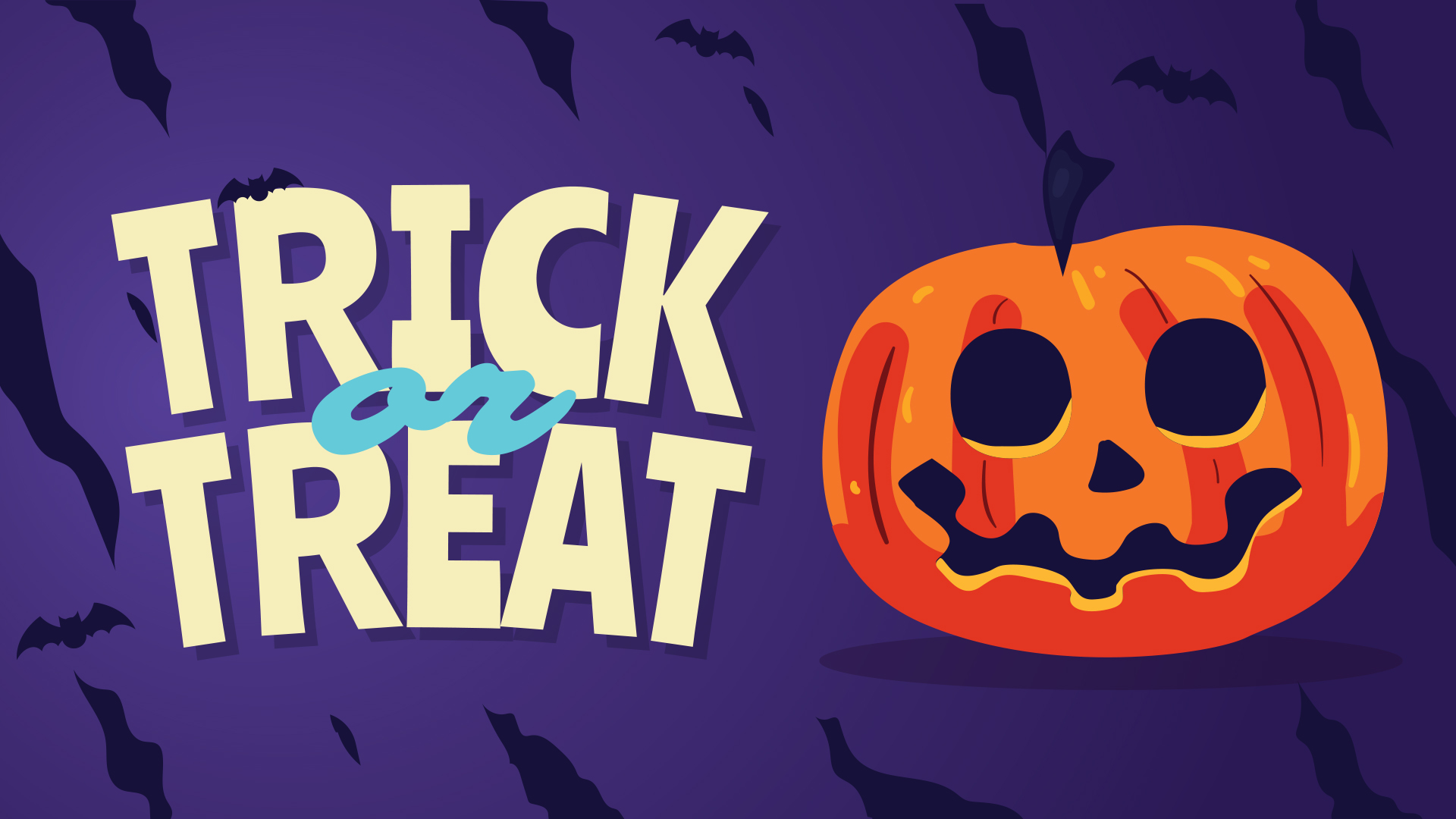
As a secular holiday, Halloween has come to be associated with a number of activities. One is the practice of wearing masks and costumes for parties and for trick-or-treating. Other popular Halloween activities include carving pumpkins or turnips into jack-o’-lanterns, lighting bonfires, apple bobbing, divination games, playing pranks, visiting haunted attractions, telling scary stories, and watching horror or Halloween-themed films. Some people practice the Christian observances of All Hallows’ Eve, including attending church services and lighting candles on the graves of the dead, although it is a secular celebration for others. Some Christians historically abstained from meat on All Hallows’ Eve, a tradition reflected in the eating of certain vegetarian foods on this vigil day, including apples, potato pancakes, and soul cakes.
Since the mid-20th century the United Nations Children’s Fund (UNICEF) has attempted to make the collection of money for its programs a part of Halloween. The program historically involves the distribution of small orange boxes by schools to trick-or-treaters, in which they can solicit small change donations from the houses they visit. It is estimated that children have collected more than $118 million for UNICEF since its inception.
Now you have read how Halloween came to be, below you will discover 54 Fun Facts about Halloween. Enjoy!!!

- This holiday has Christian origins that dates all the way back to 1745.
- This holiday was not called All Hallows Eve until 1556.
- The tradition of Halloween comes from Samhain, an ancient pagan festival celebrated by Celtic people. It took place in Britain, Ireland and Northwest France.
- The emerald isle is actually home to Halloween! At the end of the harvest season the ancient Celtic people of Ireland celebrated Oiche Shamhna, which translates to Halloween, a pagan festival marking the beginning of the darker half of the year.
- By fooling the devil he was forced to walk the earth with only burning coal inside his carved turnip to light his way. His new name was Jack of the Lanterns.
- An intense and persistent fear of Halloween is called Samhainophobia. Unlike today’s light-hearted and candy-filled holiday, a festival of the dead was believed to be the day when the gates of hell would open and unleash wandering angry spirits.
- Halloween celebrations date back 2000 years as a traditional pagan traditions.
- A full moon on Halloween is actually very rare, it only happens four or five times a century. The last time was Halloween 2020, and the next will be Halloween 2039!
- The word witch comes from the Old English wicce, meaning wise woman. At one time, these women were highly respected. According to popular belief, witches held meetings, known as sabbats on Halloween night.
- In Scotland, young girls placed wet sheets in front of an open fire or watched a mirror at midnight to catch a glimpse of their suitor’s face.
- There are many beliefs regarding birth on Halloween day. One of them includes being born with the ability to be able to communicate with ghosts and spirits.

- Trick-or-Treating began in areas of the UK and Ireland – Poor people would go house-to-house souling, where they asked for small breads called soul cakes in exchange for prayer.
- Once upon a time, people in Ireland used turnips rather than pumpkins to decorate their homes for Halloween.
- When you think of pumpkins, you automatically associate them with Jack-O-Lanterns, but that wasn’t always the case. Traditionally, the Irish used large turnips and potatoes for carving the first Jack-O-Lanterns. Upon bringing the practice to America, the use of pumpkins soon took over, probably as a less-smelly alternative.
- Halloween is called the Day of the Dead in Mexico. On this date people tidy the graves of relatives and leave offerings of food and drink. Like Mexico, Japan as a similiar holiday but they call it Obon.
- While pumpkins are typically orange, they can also be green, white, red and gray.
- Jack-o’-lantern comes from irish folktale, about a man named Stingy Jack who kept playing tricks on the devil. When Jack died, the devil punished him by forcing him to walk the Earth with only a carved-out turnip and burning coal inside to help light his way.
- The fastest pumpkin carving record goes to Stephen Clarke who carved a pumpkin in just over 16 seconds.
- Halloween traditions during the 18th century, was supposed to help single ladies meet their romantic match. Women would throw apple peels over a shoulder, hoping to see their future husband’s initials in the pattern they made when they landed.
- In Ireland its not just candy that is important to them, it also includes a sweet bread called Barnbrack, which serves as its official Halloween dessert.
- October 30th, the night before Halloween is called Mischief Night or Goosey Night. Its when teens and tweens pull pranks. Anything from toilet papering the trees outside someone’s house, to egging cars and more dangerous capers,
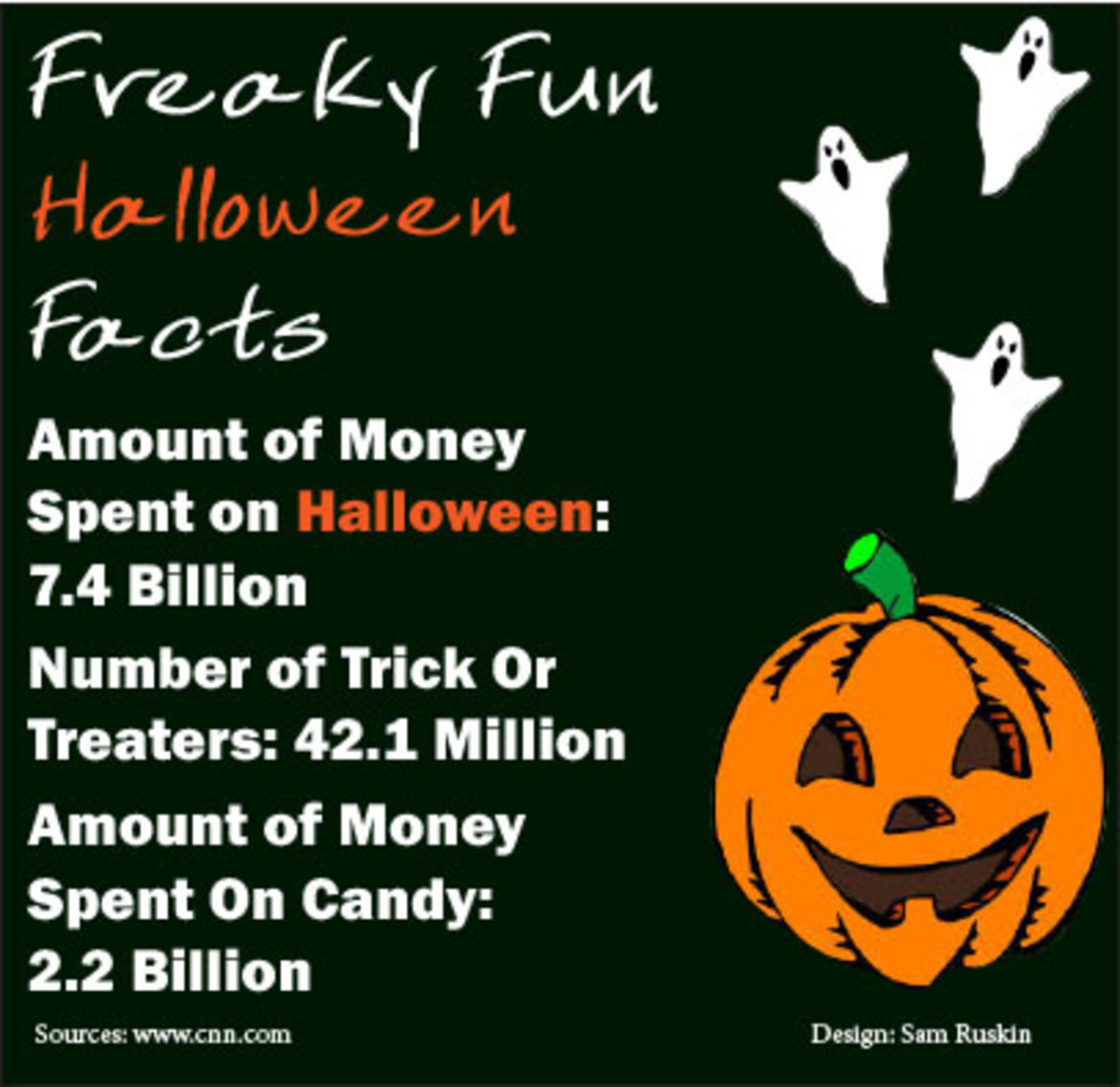
- Trick or Treating has been around since medieval times. Back then, it was known as “guising” in Scotland and Ireland. Young people dressed up in costumes and went door-to-door looking for food or money in exchange for performing songs, poems or other “tricks.”
- Orange and black are the traditional colors of Halloween. Orange represented the time of year with the harvest season and falling leaves. The black symbolizes darkness.
- Black cats, spiders, and bats are all Halloween symbols because of their historical ties to Wiccans. These animals were thought to be the companions of witches in the Middle Ages, and are often associated with bad luck.
- According to folk tradition, if you wear your clothes inside out on Halloween and walk backwards at midnight, you’ll see a ghost.
- The Village Halloween Parade in New York City is the United States’s largest Halloween parade, involving 50,000 participants and over 2 million spectators.
- Sugar was rationed in the United States durring WWII, and for several years children had to refrain from trick-or-treating. They’ve certainly made up for this since; in 2018 Americans spent $2.5 billion on sweets at Halloween.
- In many cultures people return to their hometowns on Halloween to purchase candles and flowers in preparation for All Saints’ Day on November 1st.
- Americans spend around $440 million a year on costumes for their pets alone. Ireland spends around £41 million each year on Halloween food, costumes and decorations for there homes.
- Despite the common phobia of spiders many people share, spotting this insect on Halloween night is considered great luck. It is believed that if you see a spider during Halloween, it means that a loved one is watching over you.
- In October 2013, Keene, in New Hampshire, holds the record for the most jack-o’-lanterns on display. The city broke the record with 30,581 lit pumpkins displayed around town.
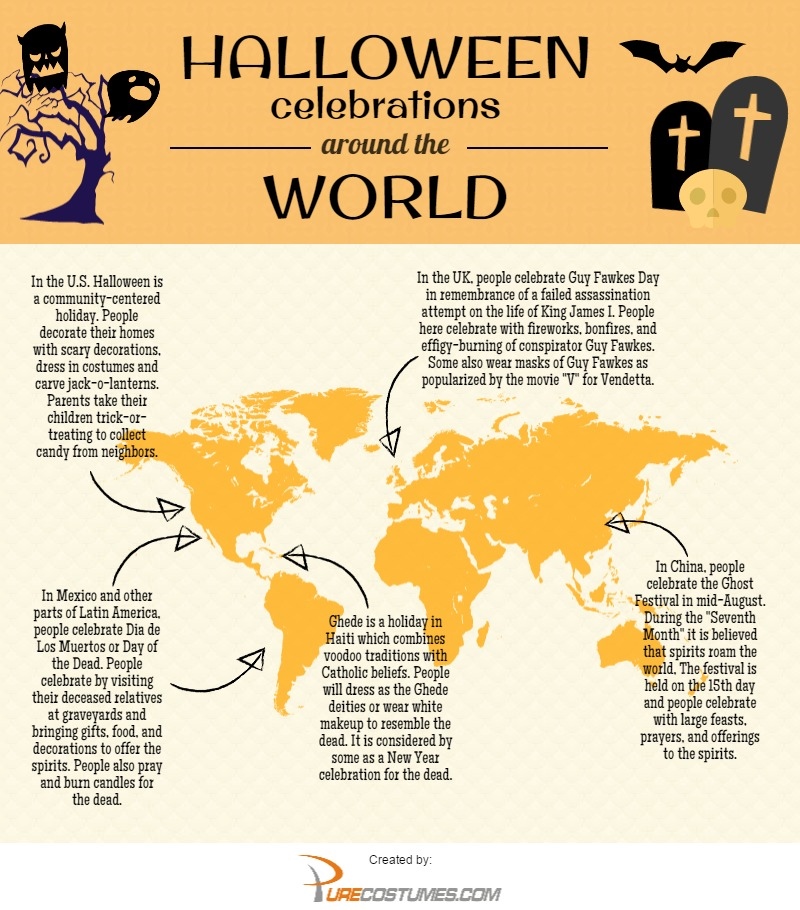
- Hocus Pocus is one of the most popular movies during Halloween. But, did you know that the original title was going to be called Halloween House, and it was almost a much freakier flick, that had a much darker and scarier script, Leonardo DiCaprio was to of played the lead role.
- Halloween has several different names; All Hallows Eve, Samhain, All Hallowtide, The Feast of the Dead, Haloween, All Saints Eve, El Dia de los Muertos (Day of the Dead).
- Travis Gienger of Anoka, Minnesota holds the current world record for growing the largest and heaviest pumpkin in the world, won the 50th World Championship Pumpkin Weigh-Off in Half Moon Bay, California, weighing in at 2,749 pounds. which could make at least 687 pies.
- The U.K.’s biggest pumpkin comes from a pair of twins, Ian and Stuart Patonset who set a new record coming in at 2,656 pounds. which broke their previous record set two years ago, with the enormous squash.
- October is also known as Owl Month and is associated with Halloween due to their nocturnal nature. It is also believed that owls once served as witches’ companions along with black cats.
- For those aged 16 and over, it is considered illegal to wear any type of costume that covers your face. Sunglasses, hoods, and anything else that covers your head or face are also prohibited.
- Halloween 2013 in New York City, Stephen Clarke earned the title for the fastest pumpkin carving at a little over 16 seconds.
- The president of the United States hands out candy every year.
- Did you know? One-quarter of all the candy sold annually in the U.S. is purchased for Halloween.
- For centuries cats were used as part of a Halloween ritual to predict the future.
- The folks of Scotland do a certain Halloween ritual, by throwing nuts into a fire. if they fracture and crack loudly, you won’t be hearing wedding bells anytime soon, but if they roast quietly, your relationship will run smoothly.
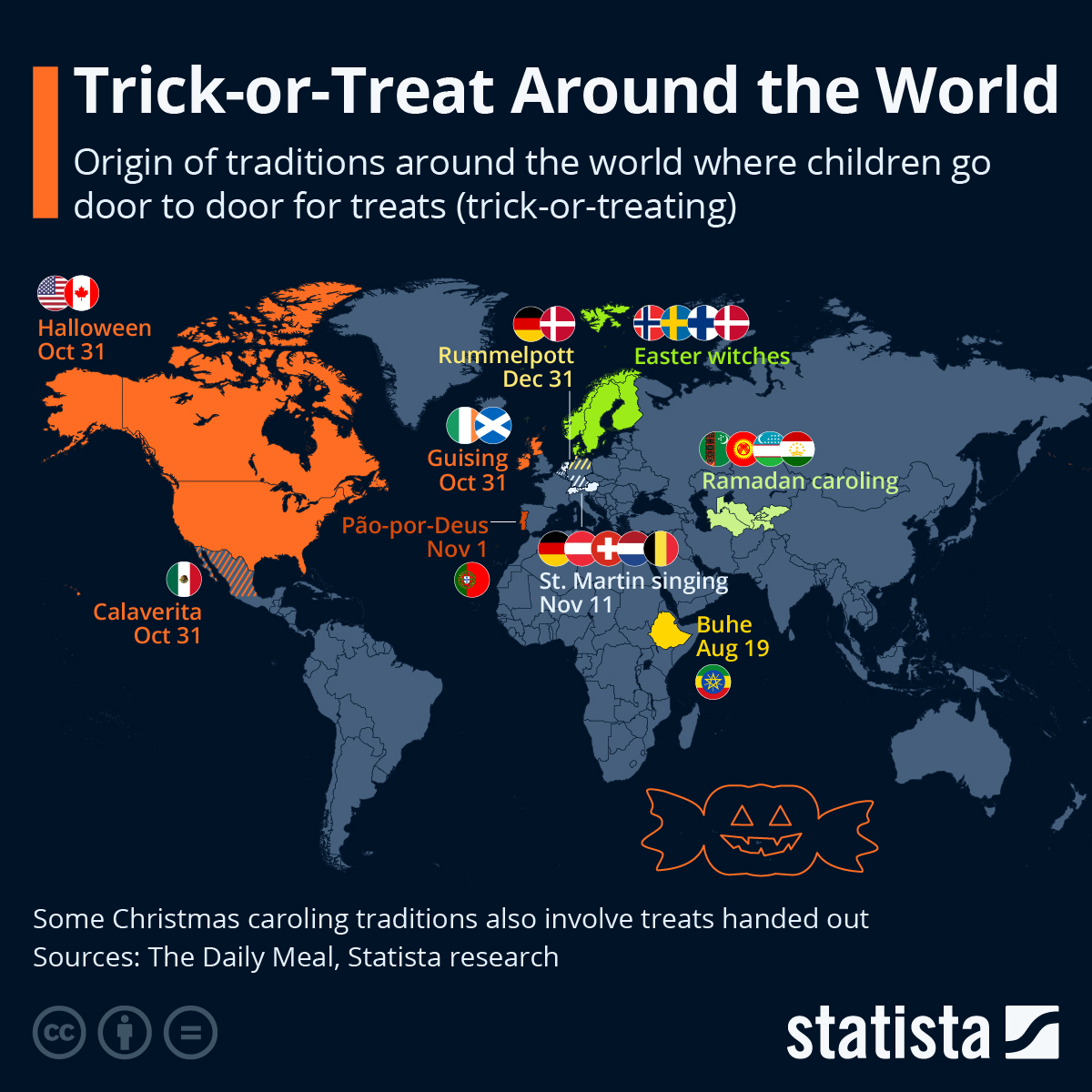
- Halloween has become the second-largest commercial holiday in the country.
- Chinese and Malaysia’s Halloween celebrations are called “Festival of the Hungry Ghosts,” and it occurs over several days, it involves honoring good spirits as well as avoiding evil ones. Malaysia also includes entertaining peformances from opera to puppet shows
- Dia de los Muertos is all about bright and lively colors. People paint their faces like skulls, called “calaveras,” and decorate them with vibrant marigold flowers and colorful papel picado (paper banners).
- The most popular costumes for kids are Superheroes (Spiderman, Batman, Wonder Woman, and Superman), Princesses, Witches, Ghosts, and Pumpkins.
- Hong Kong natives refer to Halloween as Yu Lan, believing it as a time where the gates of hell open to unleash spirits that haunt the living.
- Americans spend over $3.5 Billion dollars a year on costumes.
- When the Irish fled the potato famine, which devastated their country in the 1840s, they brought their Halloween traditions with them. The celebration spread across the country, until the mischievous Halloween pranksters reached an all-time high in the 1920s.
- Over 35 million people go trick-or-treating each year.
- A city in Canada has banned anyone over 16 from trick-or-treating, if you are caught trick-or-treating in Bathurst, Canada, you can face up to a $200 fine. The city also has a curfew for all residents, so even those under 16 aren’t allowed out after 8 p.m. on Halloween.
- Some countries such as Australia believe that Halloween is an unwanted holiday.
- Canton, Ohio has the largest haunted house in the world. It is known as the Factory of Terror, It was founded in 2002, and has since attracted thousands of people from all over the world.
Thanks for taking the time to read my post. Happy Halloween to you all, have a great weekend, be safe and I will see you next week.
